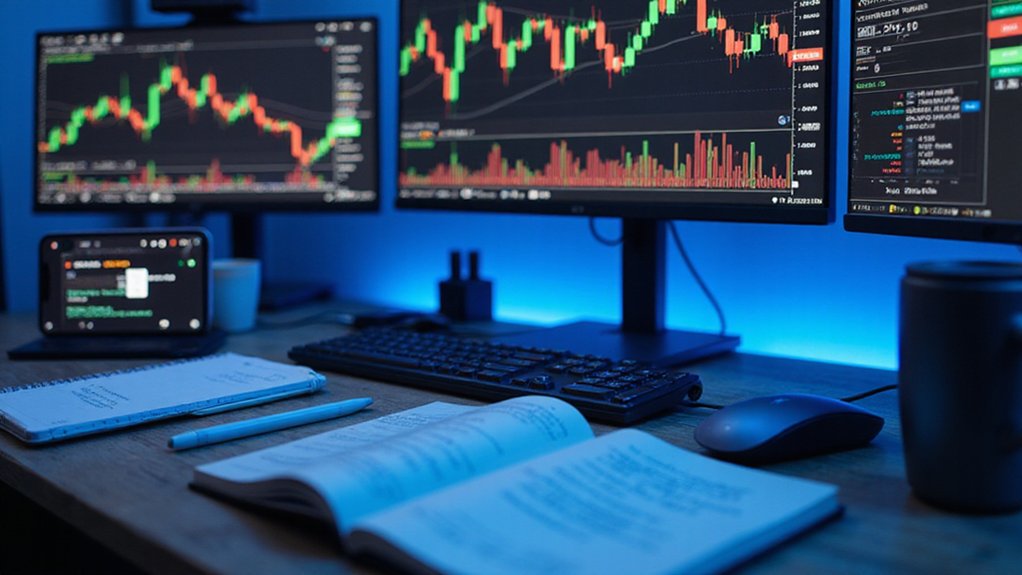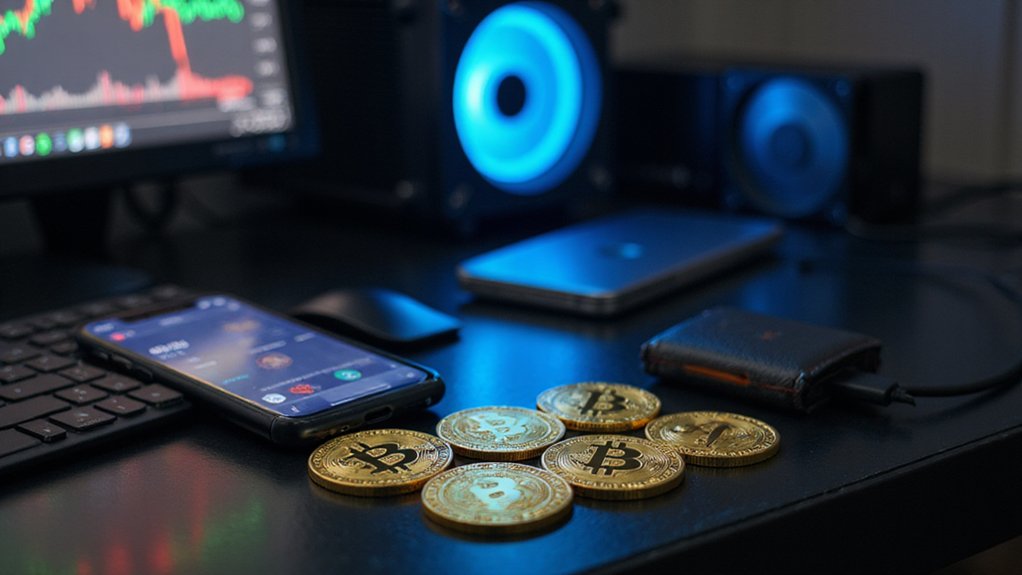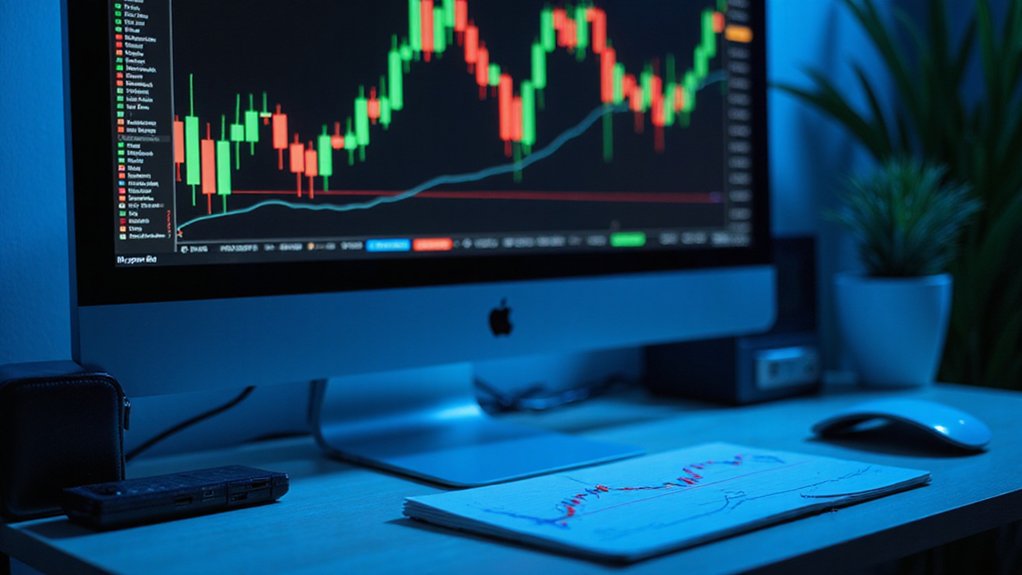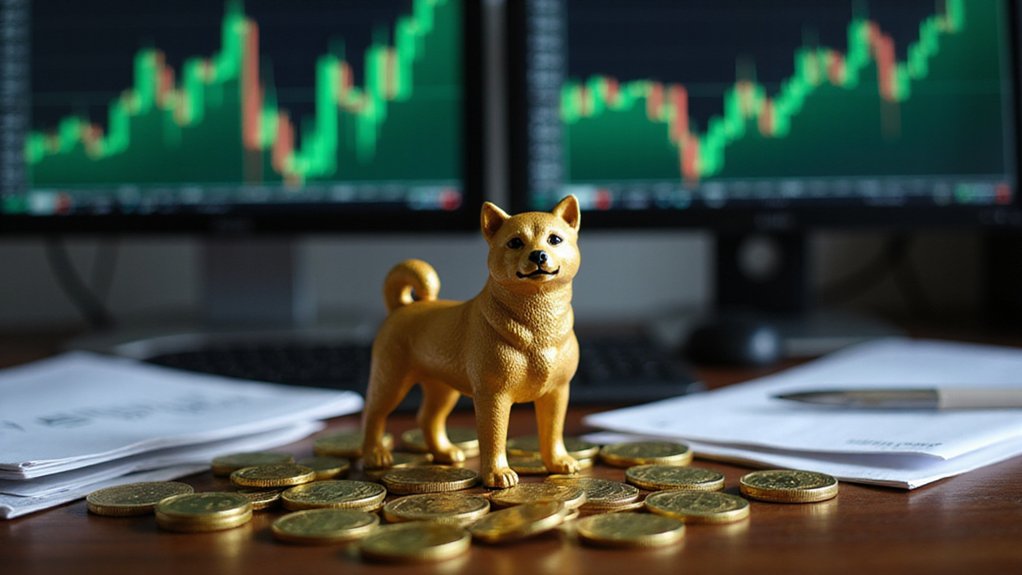Cryptocurrency day trading requires mastering volatility through disciplined technical analysis and risk management. Successful traders utilize timeframes aligned with their availability—15-minute charts for scalping, 4-hour frames for trend identification—while employing candlestick patterns, moving averages, and Bollinger Bands to inform decisions. Limiting exposure to 1-2% per trade proves essential, as does implementing automated stop-losses to protect capital. The most profitable strategies—scalping, breakout trading, and arbitrage—demand psychological fortitude against the twin sirens of FOMO and revenge trading. The subsequent sections illuminate these concepts in practice.
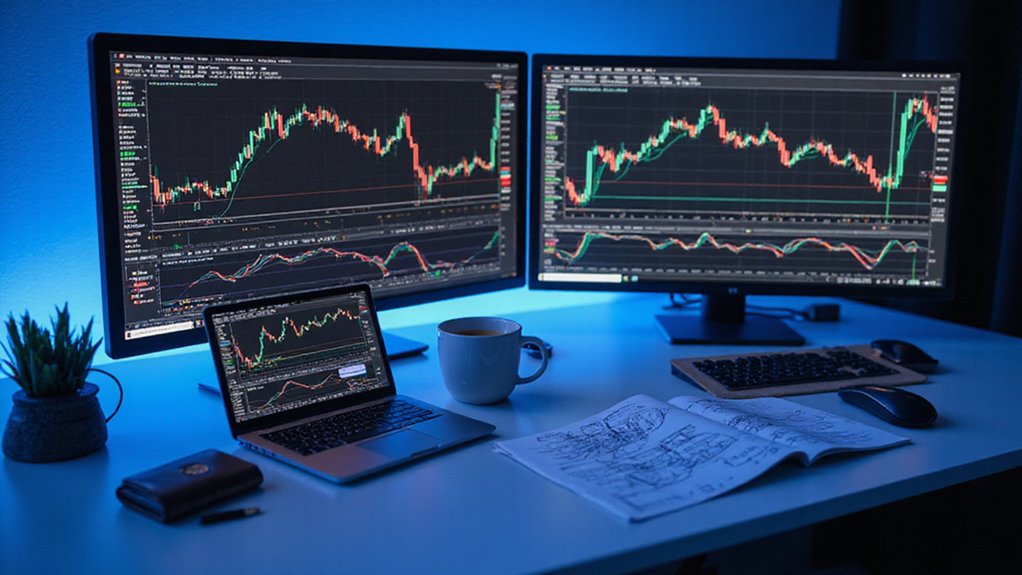
Why do cryptocurrency markets entice so many day traders, despite their notorious volatility? The answer lies precisely in that volatility—these digital asset markets offer profit potential that traditional securities simply cannot match, albeit with commensurate risk profiles that would make conventional brokers blanch.
Successful cryptocurrency day traders invariably employ a disciplined approach to time frame selection.
While 15-minute and hourly charts capture the frenetic price movements that create scalping opportunities, 4-hour intervals provide the broader context necessary for identifying genuine trends rather than mere noise.
One must align these temporal choices with personal trading goals and availability—a trader who cannot monitor positions continuously should avoid the shortest time frames (a lesson typically learned the expensive way).
Technical analysis forms the cornerstone of cryptocurrency day trading methodology.
Candlestick patterns reveal market psychology with remarkable precision; moving averages establish trend directions; Bollinger Bands quantify volatility parameters; Fibonacci retracement levels indicate potential reversal points; and volume analysis confirms whether price movements represent genuine market sentiment or merely transient fluctuations. Understanding the real body components of candlesticks helps traders identify whether buyers or sellers controlled the market during specific periods.
The distinction between trading success and failure often hinges not on strategy sophistication but on risk management discipline.
Limiting exposure to 1-2% of capital per trade, implementing automated stop-loss orders, establishing predetermined take-profit levels, and calculating position sizes proportionate to account balance collectively form a protective framework against the market’s capricious nature. The transparency provided by blockchain technology ensures that all transactions are verifiable and secure, giving traders confidence in the integrity of their trades.
Various execution approaches exist within the day trading spectrum—scalping for minimal but frequent gains, breakout trading at resistance/support breaches, range trading between established boundaries, and even arbitrage across exchanges with price discrepancies.
Each requires specific tools: real-time charting software, exchange APIs, and possibly automated trading systems.
The pitfalls await the unwary: chasing losses (the trader’s equivalent of quicksand), ignoring fee structures (death by a thousand cuts), excessive leverage (financial self-immolation), and perhaps most dangerous of all, FOMO-driven entries that invariably coincide with local price maxima.
Trading cryptocurrencies is not for the emotionally fragile—the market remains entirely indifferent to one’s financial needs or trading narrative.
Frequently Asked Questions
How Much Money Do I Need to Start Day Trading Cryptocurrency?
While no legal minimum exists (unlike equities’ $25k PDT rule), realistically one needs $1,000-$5,000 to day trade cryptocurrency effectively.
Though exchanges permit $100 deposits, fee structures (0.1-0.2% per trade) rapidly erode undercapitalized accounts.
Proper risk management—limiting exposure to 1-2% per position—demands sufficient capital.
Ambitious traders targeting $100-300 daily profits should consider $3,000-$5,000 starting capital, with $10,000+ providing necessary buffer against crypto’s notorious volatility (those 20% daily swings aren’t for the faint-hearted).
What Tax Implications Should I Consider When Day Trading Cryptocurrency?
Day traders face considerable tax complexities.
Each trade constitutes a taxable event—regardless of whether one converts to fiat—with profits taxed at ordinary income rates (potentially reaching 37%).
The sheer volume of transactions necessitates meticulous record-keeping of cost bases and proceeds.
Tax software specifically designed for crypto traders becomes less luxury than necessity, while loss harvesting strategies may offer some consolation against the inevitable tax burden that accompanies successful trading activities.
Is Day Trading Cryptocurrency Legal in All Countries?
Cryptocurrency day trading inhabits a legal patchwork globally—hardly surprising given regulators’ perpetual game of catch-up with financial innovation.
While Bulgaria, Romania, and Georgia explicitly permit trading (often with tax implications), nations like China, Algeria, and Morocco have implemented total bans.
Most jurisdictions fall somewhere between these poles, with evolving regulatory frameworks that may permit trading while imposing increasingly stringent AML/KYC requirements.
Even in “crypto-friendly” countries, compliance with local licensing regimes remains essential.
How Do I Handle Cryptocurrency Day Trading-Related Stress?
Cryptocurrency day traders should implement structured risk management (capping trade sizes at 1-2% of portfolio—a figure remarkably few adhere to), establish firm trading schedules with mandatory breaks, and leverage automation tools to minimize emotional decision-making.
The psychological toll of 24/7 markets cannot be understated; mindfulness practices and community support forums provide valuable counterbalances.
For those experiencing addiction-like behaviors, professional help from therapists specializing in financial stress may prove necessary—day trading and gambling aren’t entirely dissimilar beasts.
Can I Use Trading Bots for Cryptocurrency Day Trading?
Trading bots can indeed enhance cryptocurrency day trading operations, offering impressive efficiency metrics (82% win rate versus manual trading’s 43%).
These algorithmic assistants excel at processing market data—analyzing over a million data points per second—while executing hundreds of trades daily with remarkable precision.
However, one mustn’t overlook their limitations; 65% fail within three months due to poor configuration, and they require substantial technical understanding to deploy effectively.
The ideal approach? Combining automated efficiency with human oversight.
